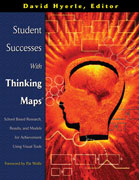



 dent Successes With Thinking Maps®
dent Successes With Thinking Maps®David Hyerle, editor with Sarah Curtis and Larry Alper co-editors
Chapter 18: Thinking Maps: A Language for Leading and Learning
Larry Alper, M.S.
“Thinking Maps help us to harness ideas and put them together in powerful ways.” “It’s the difference between seeing a pyramid and knowing how to build it.”
Teacher
The ability of people to make meaning together, visualize the unknown, and formulate effective action is vital to the success of any organization. In today’s school environment, where change is not an event but an ever present reality, it is imperative that people develop the individual and collective capacity to process information, transform it into new understandings, and shape their futures. Constructivist conversations awaken people to possibilities and help them give shape to ideas not yet fully formed. The collaborative nature of these conversations helps organizations build an identity around a common purpose. Constructivist conversations provide a way for members of the learning community to share their individual frames of reference and develop trust and confidence in themselves and each other. The construction of knowledge and meaning is not solely an individual activity but is, more powerfully, a social one. In this way, groups of people interact to interpret, reflect upon, and examine each other’s ideas and experiences. As people experience uncertainty together in this context, ambiguity is embraced as the realm of possibility. Trust, respect, and colleagueship develop through collective engagement with compelling ideas and the collaborative meaning-making process.
David Hawkins (1973) describes the importance of having, “ . . . some, third thing . . . in which they can join in outward projection” to move people beyond self-consciousness and the conventions of their thinking. This third thing can open the space for possibilities to exist and be jointly constructed. Thinking maps become the third corner of Hawkins’ “I-Thou-It” triangle and provide us with the “common engrossment for discussion.” The use of thinking maps promotes curiosity, thinking in action, and collaboration. They give us the confidence to embrace complexity and deepen our appreciation for each other’s ideas and experiences.
Student Successes With Thinking Maps including the following sections in Mentoring Mathematics Teaching and Learning:On the most fundamental level, thinking maps help us to have the conversations that truly make a difference in how we think and in what we are able to do with our ideas. In the context of the profusion of challenges we face as educators, these tools are essential to the pursuit of our collective ideals and aspirations. “All we can do . . .” writes Maxine Greene, “is cultivate multiple ways of seeing and multiple dialogues in a world where nothing stays the same.”
Read the complete chapter in the book Student Successes With Thinking Maps. Key sections from the chapter Thinking Maps: A Language for Leading and Learning with excerpts above include:
- Creating the Space
- Thinking Maps: A Language for Leading and Learning
- Examining Our Practices
- Seeing Openings and Opportunities
Larry Alper, M.Ed. is Director of Projects for DFT, leading implementations of Thinking Maps in whole schools while also supporting schools and school systems in developing long term plans for implementing these tools. In the last fours years of an 18 year career as an elementary school principal in Brattleboro, Vermont Larry facilitated the successful implementation of Thinking Maps and Software and Write From the Beginning. He also investigated how he and his colleagues could use Thinking Maps as collaborative tools for building leadership capacity. This process led him to co-author the new guide and training, Thinking Maps: Leading with a New Language.
Contact Larry at lalper@sover.net
![]() Click here (pdf file) to download Research Highlights from
Click here (pdf file) to download Research Highlights from
Student Successes With Thinking Maps
For more on Student Successes With Thinking Maps go to the following links: